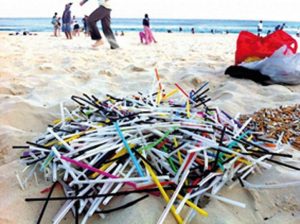Plastic is already abundant in our daily lives. When I wake up in the morning, I need to use my plastic toothbrush to brush my teeth, use toothpaste from a plastic tube, and comb my hair with a plastic comb. Waking up in the morning requires this large amount of plastic for one individual. How huge would that amount be for one student at Furman University in South Carolina or even the entire United States?
Plastic is the main component of the necessities of daily use, such as candy containers, drink bottles, and to-go meals. Because of its lightness and its convenience, even though this thing was introduced to us in the 20th century, plastic has become the thing without which we cannot live. However, plastic is damaging our lives now indefinitely since it cannot be disposed of. In other words, once it is produced, it can exist almost forever. Therefore, after it is used, plastic can be everywhere and is going to remain in our landfills or oceans. Even though we can dispose of it in some chemical way, it will create toxic chemicals in our daily lives through the water, air, or something else.
At Furman, there is a new policy about not using plastic straws. This policy is popular everywhere on campus. At the Dining Hall, we cannot find plastic straws anywhere; at the Cafe, we notice that people here recommend paper straws instead of plastic straws. At this point, I would like to talk about the damage from plastic straws to the ocean.
Most plastic straws are hard to recycle because they are too lightweight to be disposed of. There are plenty of plastic straws produced for people’s use. With the fact that just the people in American use over 500 million plastic straws every day, which end up in our oceans (www.strawlessocean.org), this circumstance will pollute the living water area for animals and cause tremendous difficulty for marine life. Not only do plastic straws harm the animals underwater, but also the animals above the sea. When some plastics do get broken up into small pieces, they can be a “meal” for the birds. Birds need to find food and ingest it, but they can mistakenly ingest plastic. These birds’ lives can easily be taken away by this daily intake of plastic straws.

As for plastic straws, they can lead to this kind of damage to the oceans. If we judge plastic things as a whole, how significant will the damage from plastic be for the environment? We need to pay more attention to plastic and try to avoid it.
From my perspective, bioplastics could be the solution to preventing plastic pollution. Plastic is too difficult to dispose of. If we can use the “disposed plastic,” which can retain the convenience and lightness of plastic, then we can be less concerned about the pollution. Today, I want to introduce the more eco-friendly polylactic acid (PLA) or Crystallized Poly Lactic Acid (CPLA). This thing can be disposed of in factories. Compared to plastic, PLA is more eco-friendly, for it is renewable and is processed from the starch of plants such as sugar cane, corn, etc. making it sustainable to the environment. The same as plastic, this material can be used for packaging, crockery, cutlery, bowls, and also for straws. The most important thing is that PLA does not produce toxic garbage for the landfills and oceans, and it can break down into natural elements.
In short, we should stop using plastic in our daily lives. At the same time, I would like to recommend using PLA to take the place of plastic since it can make our planet a better place.
-Yan Yan
source:
- www.strawlessocean.org